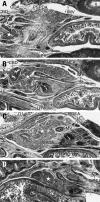Fetal topographical anatomy of the pancreatic head and duodenum with special reference to courses of the pancreaticoduodenal arteries
- PMID: 20376893
- PMCID: PMC2852796
- DOI: 10.3349/ymj.2010.51.3.398
Fetal topographical anatomy of the pancreatic head and duodenum with special reference to courses of the pancreaticoduodenal arteries
Abstract
Purpose: The purpose of this study is to provide better understanding as to how the "double" vascular arcades, in contrast to other intestinal marginal vessels, develop along the right margin of the pancreatic head.
Materials and methods: In human fetuses between 8-30 weeks, we described the topographical anatomy of the vessels, bile duct, duodenum as well as the ventral and dorsal primordia of the pancreatic head with an aid of pancreatic polypeptide immunohisto-chemistry.
Results: The contents of the hepatoduodenal ligament crossed the superior side of the pylorus. Moreover, the right hepatic artery originating from the superior mesenteric artery ran along the superior aspect of the pancreatic head. An arterial arcade, corresponding to the posterior pancreaticoduodenal arteries, encircled the superior part of the pancreatic head, whereas another arcade, corresponding to the anterior pancreaticoduodenal arteries, surrounded the inferior part. The dorsal promordium of the pancreas surrounded and/or mixed the ventral primordium at 13-16 weeks. Thus, both arterial arcades were likely to attach to the dorsal primordium.
Conclusion: The fetal anatomy of the pancreaticoduodenal vascular arcades as well as that of the hepatoduodenal ligament were quite different from adults in topographical relations. Thus, in the stage later than 30 weeks, further rotation of the duodenum along a horizontal axis seemed to be required to move the pylorus posterosuperiorly and to reflect the superior surface of the pancreatic head posteriorly. However, to change the topographical anatomy of the superior and inferior arterial arcades into the final position, re-arrangement of the pancreatic parenchyma might be necessary in the head.
Conflict of interest statement
The authors have no financial conflicts of interest.
Figures







Similar articles
-
[Anatomy of the head of the pancreas and various limited resection procedures for intraductal papillary-mucinous tumors of the pancreas].Nihon Geka Gakkai Zasshi. 2003 Jun;104(6):460-70. Nihon Geka Gakkai Zasshi. 2003. PMID: 12854493 Review. Japanese.
-
Study of surgical anatomy for duodenum-preserving resection of the head of the pancreas.Ann Surg. 1995 Apr;221(4):359-63. doi: 10.1097/00000658-199504000-00005. Ann Surg. 1995. PMID: 7726671 Free PMC article.
-
Practical guidelines for the preservation of the pancreaticoduodenal arteries during duodenum-preserving resection of the head of the pancreas: clinical experience and a study using resected specimens from pancreaticoduodenectomy.Hepatogastroenterology. 2001 Jan-Feb;48(37):264-9. Hepatogastroenterology. 2001. PMID: 11268981
-
The pancreaticoduodenal arteries in human foetal development.Folia Morphol (Warsz). 2004 Aug;63(3):281-4. Folia Morphol (Warsz). 2004. PMID: 15478102
-
Vascular anatomy of the pancreaticoduodenal region: A review.J Hepatobiliary Pancreat Surg. 1999;6(1):55-68. doi: 10.1007/s005340050084. J Hepatobiliary Pancreat Surg. 1999. PMID: 10436238 Review.
Cited by
-
Computer-assisted three-dimensional reconstruction of the fetal pancreas including the supplying arteries according to immunohistochemistry of pancreatic polypeptide.Surg Radiol Anat. 2012 Apr;34(3):229-33. doi: 10.1007/s00276-011-0844-4. Epub 2011 Jun 29. Surg Radiol Anat. 2012. PMID: 21713410 Free PMC article.
References
-
- Bertelli E, Di Gregorio F, Bertelli L, Mosca S. The arterial blood supply of the pancreas: a review. I. The superior pancreaticoduodenal and the anterior superior pancreaticoduodenal arteries. An anatomical and radiological study. Surg Radiol Anat. 1995;17:97–106. 1–3. - PubMed
-
- Bertelli E, Di Gregorio F, Bertelli L, Civeli L, Mosca S. The arterial blood supply of the pancreas: a review. II. The posterior superior pancreaticoduodenal artery. An anatomical and radiological study. Surg Radiol Anat. 1996;18:1–9. - PubMed
-
- Murakami G, Hirata K, Takamuro T, Mukaiya M, Hata F, Kitagawa S. Vascular anatomy of the pancreaticoduodenal region: a review. J Hepatobiliary Pancreat Surg. 1999;6:55–68. - PubMed
-
- Sakamoto Y, Nagai M, Tanaka N, Nobori M, Tsukamoto T, Nokubi M, et al. Anatomical segmentectomy of the head of the pancreas along the embryological fusion plane: a feasible procedure? Surgery. 2000;128:822–831. - PubMed
-
- Paulin C, Dubois PM. Immunohistochemical identification and localization of pancreatic polypeptide cells in the pancreas and gastrointestinal tract of the human fetus and adult man. Cell Tissue Res. 1978;188:251–257. - PubMed
Publication types
MeSH terms
LinkOut - more resources
Full Text Sources
Miscellaneous

